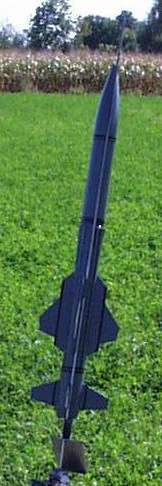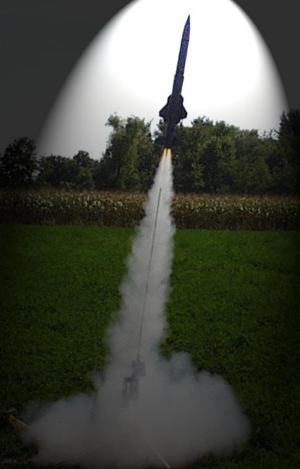| Length: | 39.25 inches |
| Manufacturer: | The Launch Pad  |
| Style: | Cluster |

(Contributed - by Chip Jenkins)
 Brief:
Brief:
The Scimitar is a mid-power Launch Pad original Surface to Air missile with
dual 24mm engine mounts and an 18" parachute recovery.
Construction:
This rocket came packed in a bag, all of the pieces were contained in the bag
and none were damaged. The 6 pages of instructions were well illustrated and
detailed. The body tube was spiral wound tube with only a light spiral to fill
(almost non-existent) The one thing that I didn't agree with (and didn't
follow) was the body tube assembly. The instructions direct you to glue the 2
tube sections together first and then glue the engine mount assembly and the
chute compartment disk in second. This would have made it harder to get the
chute disk in properly although it would have been possible either way.
The next thing was the sandwiched main "wings", if you follow the instructions to the letter, you would end up with an open area between the two fins that attach to the airframe. If I would have left this area open, it would have been impossible to finish. I filled them with a small sliver of balsa and it turned out good.
The fins needed to be cut from soft balsa wood stock from templates that were provided. It's a good thing that it was soft balsa too, because there is a lot of it to cut, sand and form. I'll address more on the fins in the finishing section.

The last thing was the light cardboard "turbojet" air intakes. The intakes are cut from light cardboard that is provided, scored, folded, and then glued to the body tube on 4 sides 45 degrees from the fins. I looked at these and tried to talk myself into leaving them off. Once I prepared them for assembly, I decided to put them on anyway, this was a good decision on my part. They look kind of cheesy when you first look at them but, once it's finished, they look nice.
Once everything was glued to the airframe, the resulting product was sturdy and solid. The parachute supplied was an 18" mylar that I didn't care for. I like nylon so I substituted an 18" ripstop nylon chute.
Finishing:
The finishing had one particular twist that I'd had not encountered before. The
soft balsa and the cardboard were to be coated with light CA before sanding.
This did make the fins sturdy but almost impossible to sand smooth. I guess I
could have sanded them until my fingers hurt but, I'm glad I did not (see the
sad end to the story). The next one I build that instructs that I apply CA to
balsa, I'm going to use the standard sanding sealer. It will take several coats
of sanding sealer but, I'm sure it will be easier to sand smooth. (or it will
just seem easier and I'm all for that)
After everything was sanded, I sprayed on a few coats of primer and sanded it down again. Then I put a coat of machinery grey paint. Then I applied some 1/8" and 1/4" automotive pinstriping. The resulting Scimitar looked very nice.
Construction Rating: 2 out of 5
 Flight:
Flight:
The recommended motors were a pair of either D12-5, D12-7, of Aerotech E15-7. I
used two D12-5's for the only launch (this is leading to the sad part of the
story). The motors were held by Estes style retaining clips, and the igniters
were tied together. I put the wadding and the parachute in and set her on the
pad and connected to the leads.
At launch, the rocket few a straight line to maybe 600 or 700 feet and then it weathercocked bad and flew at about 40-50 degrees to the horizontal (best guess) this was not the fault of the rocket (I'm guessing again) but my fault. The wind was not exactly calm but it was not continuous either. I would guess that the large fin area in conjunction with the wind gusts well above my head contributed to the arrant flight path.
Recovery:
The shock cord was long enough but it attached by a piece of heavy paper in an
Estes style. I didn't have a big problem with the way the recovery system was
set up. From my vantage point on the ground, I saw the ejection and the
parachute high in the sky. Now this is the sad part. Since the flight path took
the rocket much farther over than I expected, I was unable to recover it. It
cleared a row of trees into a field on the other side of the tree line. I
figured that I missed the trees so I would be able to go to the field on the
other side of the trees and search for my rocket. Once I passed through the
trees, I discovered that the field was not empty but, full of field corn about
8 foot tall. I did buy a piezo locator but, I didn't have it ready for
installation. I should have been working on that instead of launching that day.
The flight was not that bad because I cant blame the rocket kit for the will of
Mother Nature.
Flight Rating: 4 out of 5
Summary:
I read some of the comments that others have written about Launch Pad kits and
I have read the comments from the Launch Pad. I will agree that it was more of
a challenge than building an Estes kit. I will also agree that the instructions
leave something out that a novice would have trouble with. I do like the fact
that the instructions leave some of the thinking to me. After all, I can't
really say "As a matter of fact, I AM a rocket scientist" if I were
unable to assemble the kit with the instructions provided. I didn't agree with
coating the balsa with CA. If several coats of sanding sealer made it necessary
to add some nose weight, then so be it. It would have been worth the time to
add it although I don't believe that nose weight would have been necessary
either way. I know that the CG was just fine without any additional adjustment.
Here's a good tip that I learned from this rocket. If you take your time building a rocket to make it look and perform well, don't be in a big hurry to lose it on the first launch. I wanted to see it fly and I needed to wait for another day. This rocket leads me to believe that the wind causes more problems to rockets with large fin area.
Overall Rating: 4 out of 5
* SPECIAL NOTE off of RMR from Chuck Barndt, President of The Launch Pad
Other Reviews
- The Launch Pad Scimitar By Stephen Morrow (April 7, 2009)
Brief: A Launch Pad original, the Scimitar is a two motor cluster, mid power rocket. Some skill in model rocket building is needed for this kit but overall it is a very easy kit to build. Construction: The parts list: Two Body Tubes 24mm Motor Tubes and Retainers Couplers Cardboard Centering Rings and Bulkhead Plastic Nose Cone Balsa For Fins Mylar ...
- The Launch Pad Scimitar (Plan) By Ted Phipps
( Contributed - by Ted Phipps - 07/10/03) Picture courtesty of The Launch Pad Brief: The Scimitar is a Launch Pad original design that is modeled after military surface-to-air missiles. This rocket is a complex two-stager that uses a cluster of three D motors in the booster and a single D in the sustainer, and includes a nifty on-board battery circuit to ignite the second stage. There ...
 |
 |
Flights
 |
 |
Sponsored Ads
 |
 |












M.T. (October 2, 2005)